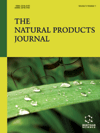- Home
- A-Z Publications
- Natural Products Journal, The
- Previous Issues
- Volume 14, Issue 2, 2024
Natural Products Journal, The - Volume 14, Issue 2, 2024
Volume 14, Issue 2, 2024
-
-
A Comprehensive Mini Review on the Natural Product Bacopa monnieri for the Management of Alzheimer’s Disease
More LessAuthors: Naman Jain, Omkar Tambekar, Tanvi Goel, Subhash L. Bodhankar and Deepali Amol BansodeCentral nervous system disorders are expected to profoundly impact the global healthcare needs of the human community in this era. Senile decay of neurons is (Alzheimers Disease) AD. The hallmark of the pathophysiology of AD disease has two pivotal features: extracellular beta-amyloid deposition and intracellular tau hyperphosphorylation. New medicine-based psychoactive treatments have met with modest effectivenes Read More
-
-
-
Studies on Secondary Metabolites and In vitro and In silico Anticholinesterases Activities of the Sea Urchin Echinometra mathaei Crude Venoms from the Persian Gulf-Bushehr
More LessAuthors: Hamideh Dehghani, Marzieh Rashedinia, Gholamhossein Mohebbi and Amir VazirizadehBackground: Echinoderms are a unique source of amazing secondary metabolites with a wide spectrum of biological activities. Several species of sea urchins contain various toxins and biologically active metabolites. One of the most attractive approaches to treat Alzheimer's disease is searching for effective marine natural products with cholinesterase inhibitory activities. Objective: The current study is designed to inves Read More
-
-
-
A Comprehensive Study on Natural Products and their Bioactive Constituents to Cure Respiratory Diseases
More LessAuthors: Avadh Biharee, Lokesh Chaudhari, Sudha Bhartiya, Shivam K. Kori, Anu Chaudhary, Dheeraj Dubey and Arpita YadavBackground: In terms of death rates, occurrence, costs, and prevalence, respiratory tract diseases, which include minor issues like the common cold and life-threatening ones like bacterial pneumonia, lung cancers, and tuberculosis, are extremely significant. People have been worried about their health for a long time because of respiratory diseases. Old-style medication has tended to these diseases; however, the accumulati Read More
-
-
-
Cannabidiol and Indole-3-carbinol Reduce Intracellular Lipid Droplet Accumulation in HepaRG, A Human Liver Cell Line, as well as in Human Adipocytes
More LessAuthors: Sanjanaa Senthilkumar, Megan E. Solan, Maria T. Fernandez-Luna and Ramon LavadoIntroduction: An increase in obesity-related diseases is becoming an alarming worldwide problem. Therefore, new therapeutic methods are constantly sought to prevent, treat, and alleviate symptoms of the diseases associated with obesity. Method: This study investigates the effects of two natural compounds (indole-3-carbinol, I3C, a bioactive indolic compound found in cruciferous vegetables; cannabidiol, CBD, the acti Read More
-
-
-
The Analgesic Effect of Ginger on Postoperative Pain: A Systematic Review of Clinical Trials
More LessIntroduction and Aim: Pain is a common problem that can negatively affect patients' daily life and impair the quality of life of patients. This systematic review evaluates ginger's analgesic effects and underlying mechanisms in postoperative pain. Methods: An extensive search was undertaken in various databases, including Cochrane Library, Pub- Med, Embase, Web of Science, and Scopus. After considering the stu Read More
-
-
-
Medicinal Importance and Therapeutic Benefit of Bioactive Flavonoid Eriocitrin: An Update on Pharmacological Activity and Analytical Aspects
More LessAuthors: Kanika Patel and Dinesh K. PatelBackground: Polyphenols are micronutrients and an important class of secondary metabolites that are naturally present in various types of plants and their derived byproducts. Humans obtain polyphenols and phytochemicals from different vegetables, fruits, spices, and teas. More than 8,000 different types of polyphenols have been isolated from different natural sources. Polyphenols play an important role in the plants’ resista Read More
-
-
-
A Review on History, Chemical Constituents, Phytochemistry, Pharmacological Activities, and Recent Patents of Valerian
More LessAuthors: Pankaj Malhotra, Neha Minocha, Parijat Pandey, Dhirender Kaushik and Neelam VashistBackground: Valerian officinalis is a variant of herbaceous flowering plants in the Caprifoliaceae family, members of which can be generally called valerians. Valerian is derived from Valerius, the Latin term “valere”, which means health or well-being. It is used as a sedative and anxiolytic in many countries. The beneficial effects of valerian have always been controversial due to inconsistent clinical trial results. Valerian contai Read More
-
-
-
Phytochemical, Pharmacological, and Toxicological Prospection of Morus nigra L.: A Systematic Review
More LessIntroduction: Morus nigra L. has industrial relevance due to the presence of specialized metabolites, which possess pharmaceutical potential in various parts and preparations. This review presents updated information on traditional, phytochemical, and pharmacological applications, as well as toxicity data, pertaining to different parts of Morus nigra L. Method: Phytochemical research and ethnobotanical studies were conduc Read More
-
Most Read This Month
Article
content/journals/npj
Journal
10
5
false
en


